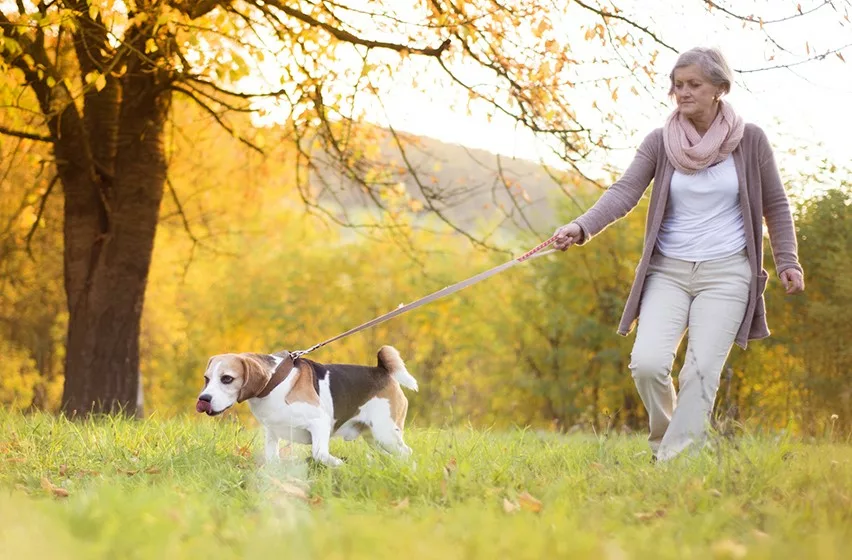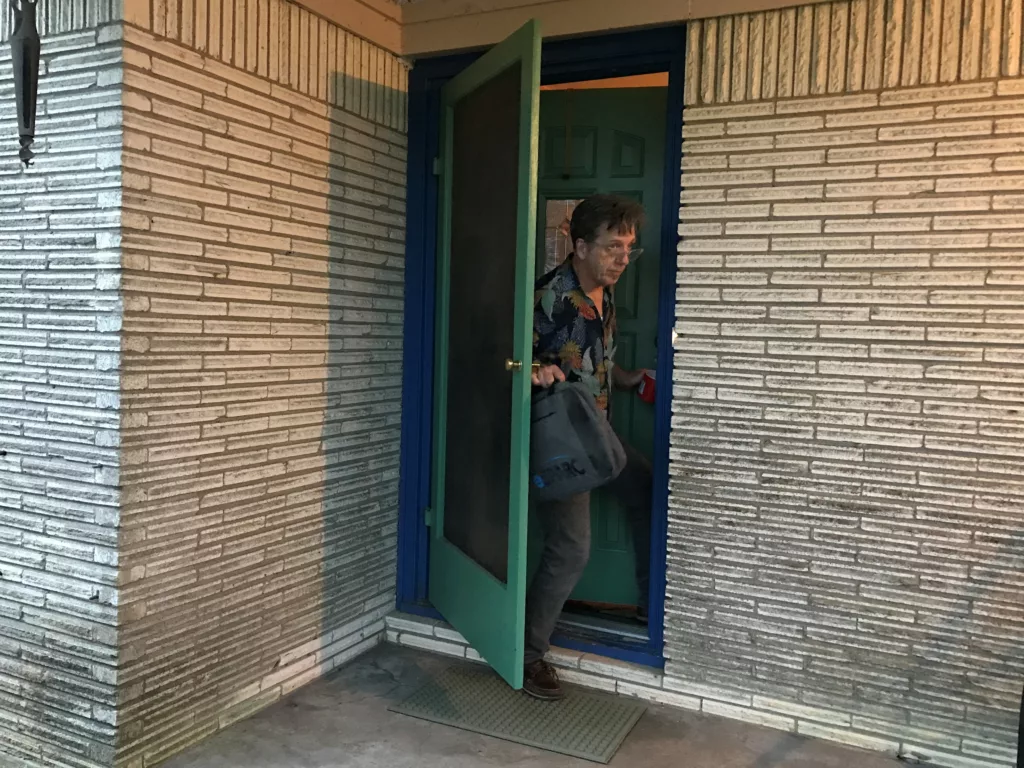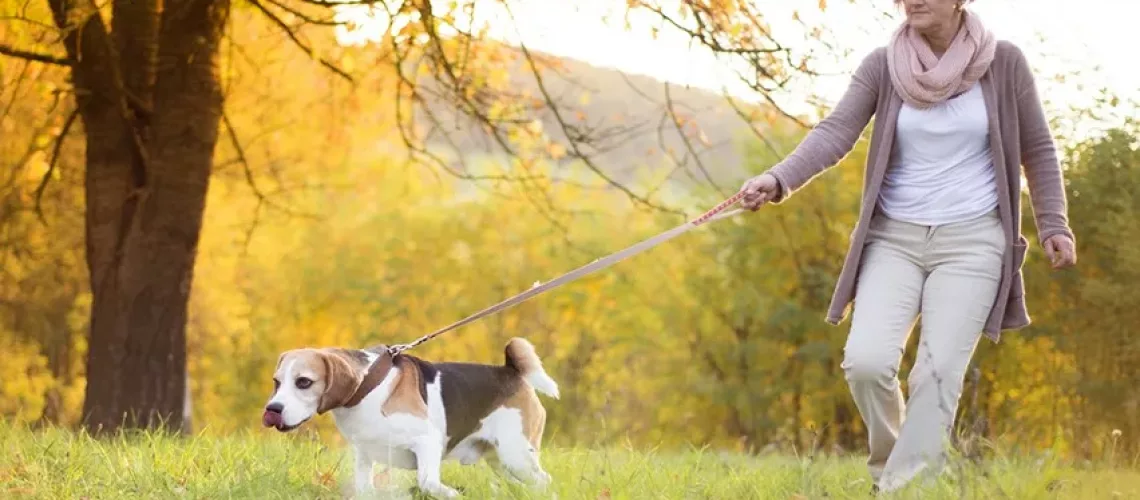What is “Normal?”
There was a time in our society when most dogs slept outside. These days, that doesn’t seem “normal.”
When I was a kid, many, if not most, dogs in the South died of heartworm disease; preventive medication and effective treatments had not yet been developed. That was “normal.” Many dogs still die of heartworm disease, but this sad outcome now seems “abnormal” since effective preventives and treatments are available.
Some dog behaviors appear to be perceived as “normal” by a great number of humans, and that probably contributes to poor attitudes about our responsibilities regarding training for our dogs.
Perhaps it’s time for a change in our perception of “normal” dog behaviors. Let’s talk specifically about dogs dragging owners on their leashes and running out the front door, two behaviors that humans spend a lot of time dealing with.
What is “Normal” Leash Walking?
How did it become “normal” to see dogs bent over, heads down, pulling hard on leashes while owners walk briskly behind with arms extended straight out from their shoulders?

Let’s normalize good behavior – dogs walking with their owners without pressure on their collars or harnesses; then spend a little time training to help both dogs and owners succeed.
Misleading Guidance About Leash Walking on Social Media
There are a couple of posts I see regularly on social media that appear to be advising people to be nicer to their dogs, but in reality may be helping people cause their dogs (and themselves) more anxiety and stress.
Let Your Dog Sniff – When You Are Both Ready
One of these common posts is, “Let your dog sniff! It’s his walk, not yours.” While this is a hearty goal to have, it’s not a good idea to take this approach until you and your dog both have the necessary skills to be successful. Social media posters don’t seem to address that. How do you let your dog sniff without creating a leash-pulling behavior and a stressful walk for both parties? You do so through training, and by postponing this activity until both of you are ready to take it on.
“Let Your Dog Be a Dog” – Can He Be Anything Else?
The other post is something along the lines of, “Let your dog be a dog! Don’t turn him into a robot.” What? First of all, how can a dog be anything but a dog? Second, quality training certainly does not result in the creation of robots.
I suspect many people still have perceptions of training as “breaking a dog’s spirit.” They may remember images of dogs performing precision behaviors which were traditionally taught using force techniques.
Over the last 25 years or so, many obedience competitors have been using positive reinforcement training, resulting in dogs looking like they’re having a fun time in the ring! There are also some military and police dog trainers using positive reinforcement, resulting in safer, more reliable operative dogs that are less “robotic” looking. There are certainly many force-based dog trainers still at work, producing dogs who are on high alert to avoid the next neck shock or pinch, or whatever physical punishment could occur. These dogs may look like “robots” to some people, but they are simply stressed, hyper-vigilant dogs trying to keep from being hurt. Skilled positive reinforcement training produces dogs who choose to walk with their handlers, ready to discover the fun in store for them, and creating a partnership that allows safety and comfort for both human and dog. They don’t have to worry about avoiding pain.
It’s Hard to Normalize What We Don’t See Often

Dogs Improve at What They Do Often – So Do Humans
Pulling on a leash is a bad habit for both humans and dogs; both species do it on a default basis, and both species can learn to do better. Leash skills, specifically being able to keep a leash loose between dog and human, are the key to comfort in walking for both species.
Tight leashes add to anxiety and stress. New rescue dogs are usually stressed due to previous experiences and changes in home environment. They may exhibit frantic or anxious behaviors that people interpret as a need for exercise, so they take the dogs out for a “walk”. Often, this isn’t much of a walk, as the dog is flitting about quickly, unable to think straight due to impulsivity brought on by stress. This is not quality exercise, nor does it provide a quality social experience. It is a learning experience that makes it more likely the dog will pull on the leash and exhibit more frantic behavior on the next walk, because dogs are always learning. Whatever they’re doing, they’re learning to do better and more frequently.
What to Do Instead?
Dogs enjoy learning when you use positive reinforcement to teach them. The Mannerly Dog has a whole series of blog posts about leash training to help you get started.
Make the effort to help your dog do the “right thing” and reinforce with treats when he does. That’s really all there is to it. Our classes can help you get better at this process. As you and your dog learn leash skills together, you can add a release cue like “Go See” to give your dog a break for sniffing or potty action. Then re-set yourself and your dog for another round of leash walking. This is how “let your dog sniff” can begin without creating a series of undesirable fallout behaviors.
Do Let Your Dog Sniff – When You Are Both Ready
The problem with letting dogs sniff before they have leash skills is that sniffing is likely to reinforce the behavior of pulling on the leash. Once both of you have good leash skills, you can use a sniffing opportunity to reinforce walking nicely on a loose leash. See the difference? You’ll be building the skills you want to build while allowing your dog to do something he really wants to do. Plus, you’ll have the ability to end the sniffing session and get your dog back to your side to walk some more. You can offer another sniffing session a few minutes later, down the road. Having control keeps you and your dog safe.
Worst-case Scenarios
What if a minor emergency occurs while your dog is having a sniff session? You know the ones:
- a loose dog walks up;
- you notice a dangerous item on the ground near where your dog is sniffing – one your dog should not eat or perhaps even come into contact with;
- you spy a fledgling bird on the ground in the area and you’d rather your little predator didn’t end its life.
It’s best to have practiced leash skills to ensure you can U-turn right out of there before something untoward happens. What you don’t want to do in an emergency situation is drag your dog out of the area on a tight leash. That defeats your goal of walking nicely together as a team by teaching your dog that a tight leash pulling on him is “normal.”
None of these behaviors is hard to teach when you keep your dog in the game by using positive reinforcement in the form of treats. All you need to do is think through the situation and make a plan. Yes, there’s a lot involved in that plan – but you can do it. The Mannerly Dog can help.
What is “Normal” Dog Behavior at the Front Door?
How did it get to be so “normal” for dogs to run out the front door or gate and be injured or lost – sometimes forever? It seems we constantly hear about a dog “slipping out the door” or escaping from the gate. People seem to shrug this off as “just what dogs do,” normalizing their own behavior of walking out the door sideways, while blocking the dog with a leg to keep the dog from coming out, too.

Let’s normalize good behavior – dogs staying in the house when their owners step through the front door, and owners walking out the door the same way they walk anywhere else. In fact, let’s also normalize dogs NOT barking and leaping at the front door when the doorbell rings.
It’s all in how you train them.
- Don’t let dogs learn things you don’t want them to know.
- Reinforce the opposite of what you DON’T want.
If you follow my advice, trust in the science of behavior, and start reinforcing behaviors you like from the moment you bring your new dog or puppy home, you’ll develop a routine at the front door that involves a dog who is quiet and curious, or perhaps comes to get you when someone comes to the door. You’ll see your dog waiting and looking at you for direction when the front door opens. If you play your cards right, you can have your dog (or cat!) move away from the door as you go out.
Training is Simple, But Not Easy
Like teaching dogs how to walk with you in a way that works for both of you in the long term, teaching them how to behave at the front door is also simple. It may not be “easy” to set aside a few minutes each day for training, but it’s certainly something you can accomplish if you try. The first step is to see these behaviors as possible.
Create the Possibility of the Behavior You Want
If you’ve seen dogs leaping on the front door and heard them barking their heads off at friends’ and family’s homes your whole life, you may need to work a little to visualize another possibility. But if you think enough about the dangers that await dogs who become aroused and race out the front door without thinking, you can certainly imagine how the “opposite” behavior would be desirable.

Once you can visualize what is possible, you can simple start reinforcing the behaviors that are “opposite” to barking, leaping on the door, and impulsively running out when it opens. Normalize good behavior and take on the responsibility of training your pet to behave in ways that are good for both of you.
Notice how often you put your leg out to block your pet from slipping out the door or gate. Notice your increasing heart-rate and shoulder tension when you hear the doorbell, knowing your dog is about to explode. It doesn’t have to be that way. You can trust your dog to be quiet and move away from the door on his own when you’ve taught him the necessary skills, and you can build all kinds of behaviors from there.
Imagine your dog hearing the doorbell, or even noticing a car pulling into your driveway, and coming to find you, wherever you are in the house. Picture your dog waiting quietly next to you as you answer the door. Visualize your dog standing 10 feet from the door as you walk out in the morning, loaded with your office gear, and there’s no need to block him with your leg. Let’s all work to normalize good behavior, knowing that our dogs and ourselves will be better off for it.
It’s possible and you can do it, simply by reinforcing the opposite of the behaviors you don’t want. Need a little help? The Mannerly Dog’s Beyond Basic Manners class teaches these behaviors and more.


